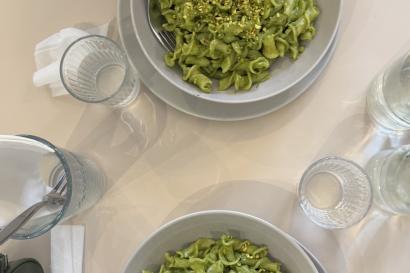1. Freiburg is really cute.
It’s from a combination of several different things: the cobblestone streets, Gothic cathedral (Münster), fresh produce stands, and numerous bicyclers, to name a few. One of my favorite features is the Bächle, which are small streams that line the streets everywhere you go. Kids often purchase little toy boats on strings to float down them. Legend has it that if you find yourself accidentally stepping into the Bächle, you have to marry someone from Freiburg (which is fine by me—the city isn’t the only thing around here that’s cute!).
2. Transportation is easy.
Getting a RegioCard is a must. It’s about $60, but it’ll let you hop on just about any tram in the city for a whole month. Once you’ve got that, the possibilities are endless: stores, restaurants, the IES Abroad Center, the train station, whatever. RegioCards are on the honor system, so you don’t have to stamp, swipe, or show them; you just jump on and jump off. (Although you can randomly be checked and fined by law enforcement if you try to ride while not in possession of a card.) There are also cabs, trains, busses, and bikes for a fee. That being said, invest in some good walking shoes as well. Most of what you need will be within walking distance, and I have a ten minute walk from classes to the tram.
3. Grocery shopping is a different experience.
Step 1: Get a reusable bag; everyone uses them, and you’ll have to buy more if you forget them at home. Step 2: Stick a Euro in the meter for collateral and rent a shopping cart. Step 3: Learn German so that you don’t have to wander around like me asking strangers “Is this thing a peach or a nectarine?” Step 4: Only buy as much as you’re willing to carry back to housing. (In the end, I put back the peach/nectarines because they were heavy.) Step 5: Realize you forgot your reusable bag and buy another one. Step 6: Kick yourself all the way to the checkout, where all the cashier does is ring up the items, so you have to bag them yourself. Step 7: Don’t trip the alarm by going out the same way you came in, then stash the cart and get back your Euro. Ta-da, shopping!
4. Germans are serious about their recycling.
You should see the pamphlet they gave me. I love that recycling isn’t optional, but I’m also a little scared I’m going to screw something up. All over the city, there are five different kinds of recycling bins: Paper, Packaging (plastics, lids), Glass (which has to be sorted by color), Compostable Waste (eggshells, tea bags), and Residual Waste (anything that’s left, which isn’t much).
5. Prepare to see some weird outfits.
After living in Germany, I don’t think any combination of clothing could surprise me once I’m back in the U.S. I’ve seen boys in capris, girls in poufy Princess Jasmine pants, bib overalls with buttons running down the front, popped collars, and so much more. The two most common things on my mind are Wonder if they speak English and What on earth are they wearing?
6. Say hello to the metric system, among other things.
No one talks about miles, it’s all kilometers. When I first got here, my housing go-to guy apologized about the cold and rainy weather, saying, “It’s usually closer to 30*C.” I said, “Oh…that’s…. yeah,” because all I knew of the metric system was that that’s somewhere between boiling and freezing. Also, they use military time, much to my chagrin. One more thing: punctuation is a bit funky. 3,50 means the same as 3.50 for currency, I’ve seen times written 7.45 instead of 7:45, and “quotation marks” are ,,quotation marks.”
7. You could die at the dinner table.
I say this because meals last a long time, and I’ve often thought, I’m going to die here, aren’t I? We’ve been here so long that I’m actually getting hungry again. The consensus seems to be that German meals are meant to be quite an ordeal, with conversation emphasized as much or even more than the food. I will say I have yet to see a bored German on their phone at the dinner table. Portions are huge, and you stay until you clean your plate and there’s nothing to take home. I’ve only seen one fast-food chain so far: McDonald’s. I’d say it was probably built with my fellow Americans in mind… we start to get itchy after sitting in a restaurant for too long.
8. Welcome to the WC.
I had forgotten this was a European thing, but the signs in trains, restaurants, etc. that say WC stand for Water Closet, aka the bathroom. Watch out, though; if it’s somewhere that sees a lot of traffic, like the train station, you might have to pay to get in, but they’re very nice inside. Don’t waste your time looking for a handle on the toilet, either; it’s usually some sort of button on the wall.
9. Roll the dice.
If you’re trying to find someone who speaks English in Freiburg, you have to take a gamble. Chances are, they will, but we’ve also learned that English-speaking usually means younger and more educated. I have run into a few cashiers and servers who don’t speak any English at all, but they were all 40+. I will say that not speaking German in Germany isn’t as big of a challenge as, say, not speaking English in America.
10. Convert your currency.
Euros are what's used, and they come in coins and bills just like USD. At the moment, €1=$1.13. HOWEVER, keep in mind that the coins can be worth quite a bit; for instance, there are €2 coins. So while your American brain might pick up a silvery coin and think Oh, a quarter, 25 cents; I think I'll toss it in the fountain, you really just lost two whole Euros.
Hope that was helpful!
Lorraine

Lorraine Engleman
<p>Hey! My name's Lorraine, and I'm a 20-year-old junior at Indiana University Southeast. I'm an Elementary Education major and substitute teacher at North Harrison Community Schools. Check out my blog as I spend eight kid-free weeks in Freiburg, Germany!</p>








